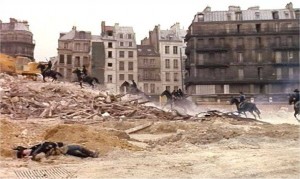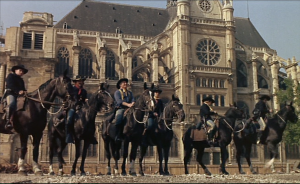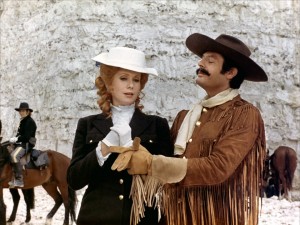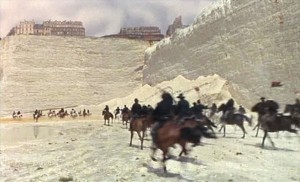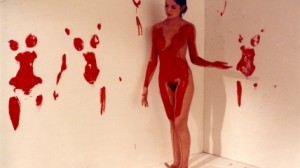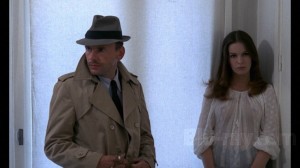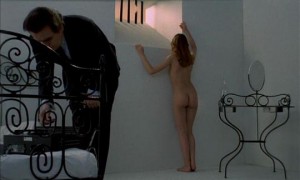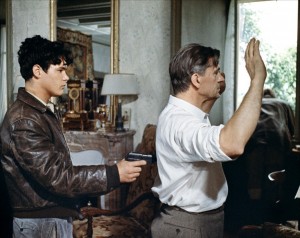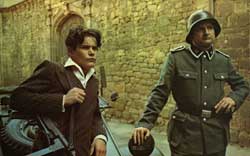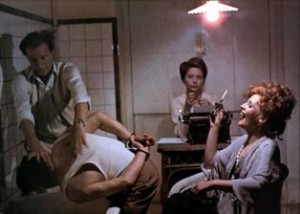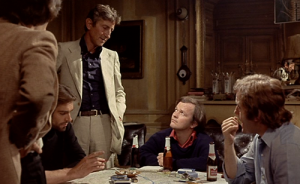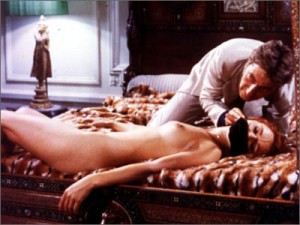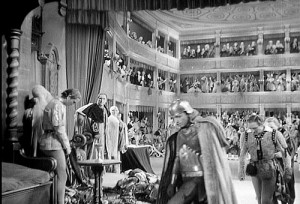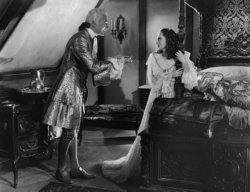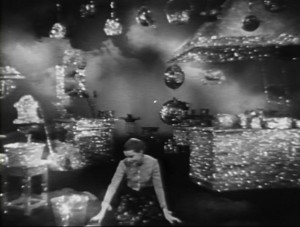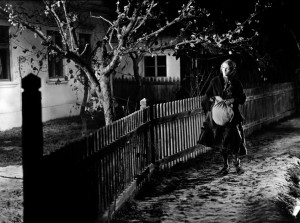From Film Comment (May-June 1974). Apart from my responses here to Malle, Whale, and Fejos, I no longer identify with most of what I wrote here, over 41 years later. Much of this -– especially my reactions to Ferreri and The Great Garrick — was strongly influenced at the time by my friendship with the late Eduardo de Gregorio. — J.R.
The word is out that Marco Ferreri’s TOUCHE PAS LA FEMME BLANCHE (DON’T TOUCH THE WHITE WOMAN) isn’t making it at the box office. The notion of staging a semi-political, semi-nonsensical Western in Les Halles seems to be bewildering French audiences, even when they laugh, and neither the presence of Michel Piccoli, Marcello Mastroianni, Philippe Noiret, and Ugo Tognazzi, nor the singular glace of Catherine Deneuve as the white woman, appears to have turned the trick. Our local Philistine, Thomas Quinn Curtiss in the International Herald Tribune, was distinctly sourced by the experience: “The subject is certainly serviceable for caricature, but Ferreri’s hand is so clumsy that the result is rather a burlesque of the cow operas of his homeland…All is grotesque, but nothing is funny in this wild, tasteless travesty that consistently misses its targets.” When I mentioned liking the film to a French colleague on the phone, I can almost swear I heard an audible shudder creep across the lines.
Well gee whiz. All I can say is that my friends and I laughed a lot, and unless I’m as totally blind as I think Mr. Curtiss is, DON’T TOUCH THE WHITE WOMAN has about as much to do with Italian Westerns as a Tex Avery cartoon. I can’t argue that the film is “sustained,” or that its anti-Americanism has anything particularly original about it. Ferreri’s instincts usually seem to matter much more than his ideas, and when the screen went red near the end of the film, I wasn’t persuaded that anything less than obvious was being expressed about American imperialism, the Third World, or even the use of color filters. On the other hand, Piccoli’s extravagant impersonation of Buffalo Bill — slangy American accent and swagger, Kentucky colonel countenance and all -– is one of the most delightful pieces of inspired acting I’ve seen in a long time; and the various ways that horses, Indians, and cavalrymen have been visually integrated into the Paris of summer 1973 are frequently ingenious and inventive, making the overall action a lot more spectacular than one would have any right to expect.
A lot of it, to be sure, is vulgar and silly. Ugo Tognazzi, playing an Uncle Tom Indian who sucks up to General Custer (Mastroianni), gets his nose twisted on several occasions in a manner befitting one of The Three Stooges; before the final battle, Deneuve declares her undying love for Mastroianni, then promptly gets shot through the neck by an arrow; the political humor stays pretty much on the level of, Tognazzi: “There are lots of Indians around – Sioux, Cheyenne….” Mastroianni: “What, no Algerians?”
Silly and vulgar, yes. But who in his right mind would want a sober and tasteful political Western set in the increasing rubble of Paris’s extinct wholesale food market? (David Susskind, maybe?) Why ask Ferreri to pretend to be a sage when he’s having so much fun throwing mud pies? It’s clear that the actors enjoyed it.
Admittedly, Ferreri’s tendency to treat a subject as a point of departure rather than a destination often winds up confusing everybody – including himself, it would appear, to judge from the tenor of his moralistic interviews. DILLINGER IS DEAD, THE AUDIENCE, LA GRANDE BOUFFE, and DON’T TOUCH THE WHITE WOMAN are all manifestly unconvincing as parables because the form demands tightness, and Ferreri seems to be rethinking his premises in almost every scene. Acts follow one another, not constructive links, and each is another hit-or-miss detail. The result is a number of loose improvisations on a given theme, but rarely (or only intermittently) a cohesive story. Yet when the improvisation is done with ebullience — and the new film has a respectable amount of it — this scattershot method begins to pay off; on the genre level of something like CAT BALLOU, it clearly triumphs.
Postscript: A rumor is afoot that the English title to be used on the film is CUSTER HAD IT COMING. If the distributors really want to destroy the film’s commercial possibilities, why don’t they call it ÉTUDE IN BRONZE instead?
***
Ferreri’s capacity to play with his actors and get them to play back is a central part of his talent. Alain Robbe-Grillet’s refusal to do much with his own actors (Olga Georges-Picot, Anicée Alvina, Michel Lonsdale; Jean-Louis Trintignant in a couple of uncredited jokey walk-ons) except fix them into pretty compositions and give them occasional lines to deliver, may help to account for the peculiar listlessness of his GLISSEMENTS PROGESSIFS DU PLAISIR (PROGRESSIVE SLIDINGS OF PLEASURE) –- a film that tries to play with varying levels of verisimilitude and usually can’t, because it essentially has only the range of pastiche to work in. From the standpoint of narrative, spinning fantasies out of a murder and its prime suspect makes sense only if the murder and suspect are established sufficiently to make them provisionally believable; and this is just what Robbe-Grillet has failed to do.
It gives me no pleasure to report this. Robbe-Grillet’s last novel, Project for a Revolution in New York, has all of the dizzying dislocations and narrative excitements that this film tries for, and more, and it is disconcerting to pass from the sheer mastery of the former to the unpersuasive and mechanical rhetoric of the latter. The paradox is how extra-“cinematic” Robbe-Grillet can be when he describes something, and how literary it becomes when he shows it on a screen: what seems real on a page becomes theoretical in front of a camera,
As a still photographer, he isn’t bad: some of GLISSEMENTS PROGRESSIFS DU PLAISIR is better than Playboy, and sexier too. (This is clear enough in the illustrations to the script, published by Éditions de Minuit.) But the exploration of erotic cliché that he has been pursuing for some time becomes less interesting when his means of exploration become themselves clichés. Indeed, when he wants to relocate an object or rearrange the components of a scene here, he frequently comes up with something that looks like a bad imitation of either Nicolas Roeg or Richard Lester attempting to approximate a Resnais film. We all still have a lot to learn from LAST YEAR AT MARIENBAD, including Robbe-Grillet.
***
“Those who cannot remember the past are condemned to repeat it.” This chestnut from George Santayana appears at the beginning of Louis Malle’s LACOMBE LUCIEN, giving us all ample warning that Malle intends to teach us a history lesson, in what is reportedly the first “important” fiction film about the German Occupation to be made in France. [2015 afterthought: What about Jean-Pierre Melville’s 1949 LA SILENCE DE LA MER, just for starters?] But the substance of this lesson is not just that certain things happened. More centrally, it is that everybody’s human, just as they are in Czech films; and even warped Gestapo stooges in Vichy France had feelings, and reasons for doing what they did, and could even be cute and awkward and touching sometimes; and morality is a complex matter requiring long and careful deliberations. Thanks a lot, Louis – without your help I might never have guessed.
The person most commonly associated with this surefire formula is Stanley Kramer, although currently it is an international phenomenon enlisting more directors than I care to think of. That Malle should be making audiences giggly and tearful with this sort of merchandise -– to the point where somebody in the new Pariscope compares him to Stendhal – can not be justified by the fact that he does it well, particularly when “well” in this case means that virtually every scene, gesture, and character trait is reduced to a carefully calculated effect, and each “subtle” effect is highlighted so that not even an idiot can miss it.
Malle is a much better technician than Kramer, so he doesn’t look nearly as crass when he puts across his pat little ironies (e.g., Gestapo officers using a portrait of Pétain for target practice). There’s even some conscientious ambiguity about whether the punk hero (Pierre Blaise) turns against the Gestapo at the end because of his love for a Jewish girl (whom he tries to protect, along with her grandmother) or in order to retrieve a fancy pocket watch that a German soldier filches from him. I couldn’t care enough about the character to appreciate this enigma, because I resented all the high-pressured nudges that Malle had been giving me like signal cards to point up his personality: having him shoot a bird and casually flick the head off a chicken to demonstrate his cruelty; using his crude gesture of thrusting a pocketful of money at his mother and the recalcitrant Jewish grandmother to establish his tongue-tied compassion. I resented still more being told in a title at the end that Lacombe Lucien was arrested and shot on such-and-such a date, while nothing at all is revealed about the fates of the girl and grandmother, who seems to take their appointed places in misty scrapbooks out of THE GARDEN OF THE FINZI-CONTINIS and THE SHOP ON MAIN STREET.
It’s a bit like being preached to and having your pockets picked at the same time: in one fell swoop, we get the manufactured nostalgia of a Bogdanovich, the sentimentality of a CABARET (Sweet Jewish Princess doomed by History), a fair amount of the Just Plain Folks rhetoric that infects most of French Pop cinema, and a few abrupt cuts at the end of scenes to disguise the fact that those who can not remember the past errors of cinema are condemned to repeat them. The “banality of evil” that we find formulated in Hannah Arendt’s Eichmann in Jerusalem and dramatized in works as diverse as MONSIEUR VERDOUX and Gravity’s Rainbow, PASSENGER and Mother Night – or trivialized in documentaries like SWASTIKA – is domesticated here to the point where it becomes flattery to everyone’s open-mindedness, ridiculously easy to take, and a kernel of wisdom to take home to the kiddies. The evil of banality is a little more like it.
What’s happened to the director who could make a film as free and subversive as ZAZIE, or as serious and honest as his PHANTOM INDIA series? It sounds terrible to put it this way, but I’m afraid he’s found his audience. Thoughtful cinema for the thoughtful moviegoer. I’m often wrong about these things, but I wouldn’t be surprised if it winds up making a mint, at least in France. All it gets from me is twelve francs and a raspberry.
***
“Nada us not into nada but deliver us from nada,” thinks the waiter in Hemingway’s “A Clean, Well-Lighted Place”. In order to say anything more substantial than that about Claude Chabrol’s NADA, fair play dictates that I return to the film and make another stab at lasting through all 130 minutes, so that I can come back with a comprehensive account of how and why I was bored to distraction. Rather than pursue such a negative project, I’d prefer to wait for the rave reviews in England and America to tell me what I missed.
To conclude on a happier note, I should confess that I’ve already seen two masterpieces this year, and it’s still only the first week in February. Both of them were made in the Thirties. James Whale’s THE GREAT GARRICK (1937), caught at the Warners season at the National Film Theater in London, is a brilliant chess game of contrasting overblown acting styles, deliriously funny, with some of the best pasteboard period décor and most flavorsome character acting to be seen anywhere. Paul Fejos’s MARIE, HUNGARIAN LEGEND (1932), with the beautiful Anabella – seen at the Cinémathèque one afternoon – is like an anthology of the best of Murnau and Pabst used to create a magical universe belonging to no one but Fejos: a glowing silent film with sound, bathed in the light of a nocturnal netherworld, that, like Fejos’s earlier LONESOME, combines elements of fairy tale and social commentary. Neither of these films is exactly easy to come by, but should they turn up in your corner of the globe any time within the next half-century or so, I’d advise you to check them out.

